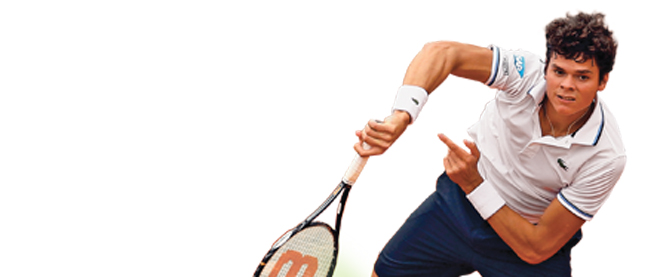How to hit a 241 km/h serve
Breaking down Milos Raonic’s big swing
Getty Images; Photo Illustration by Taylor Shute
Share

Milos Raonic, currently ranked 29th in the world, has a harder serve than almost anyone else alive. The 20-year-old from Thornhill, Ont., who will miss this year’s Rogers Cup due to a hip injury, regularly tops 230 km/h with his serve. (His top speed of 241 km/h in Memphis this year is the fifth-fastest serve ever recorded). Casey Curtis, who coached Raonic for nine years, breaks down his former star pupil’s number one weapon.
The building blocks:
“He’s got a lot of leverage,” says Curtis. “Most of the great servers are six three, six four.” (Raonic is six foot five.) He also has long arms and unusually flexible shoulders. “Some guys just have the ability to contract their muscles faster than others.”
The arm:
When Raonic serves, he swivels his arm from the shoulder down. As the racquet head twists, he drops it behind his back, and his flexible shoulder allows for a greater than normal dip. The racquet whips from his shoulder, rotates at the forearm and snaps at the wrist, turning over to drive into the ball at maximum speed.
The toss:
By striking the ball high, Raonic directs most of his power horizontally, helping to maximize racquet speed. A shorter player has to drive up to get the ball over the net, losing speed in the process.
The trunk:
During the serve, Raonic’s right buttock dips further than the left, helping twist his torso so that his back briefly faces his opponent. “Your body at that point should be in a sideways position, like you’re doing a squat or preparing to jump,” says Curtis. “You’re trying to get strength out of your legs and trying to transfer that power through to the hip area.” Raonic then leaps up and out over the court. By the time he connects with the ball, his chest is almost parallel to the net, his body having turned in a power-generating spin. The goal is for Raonic to preserve angular momentum, transferring energy from the larger muscle masses in his lower body through his core and into his shoulder, like a whip.
Below the waist:
When lining up to serve, Raonic’s left foot stands perpendicular to the baseline. His left toe rocks up as he tosses the ball. The heel stays on the ground then shifts toward the baseline as his body uncoils. “That’s a tick,” says Curtis. “Players do different things like that. If you watched Pete Sampras, the whole front of his foot would come up. Goran Ivanisevic used to turn his feet completely as he was going through his motion.” Unlike Sampras, Raonic starts with his weight forward, says Curtis. When his toe comes down, his feet end up essentially parallel to the line. Curtis says Sampras was the greatest server of all time, but he thinks Raonic could easily become the most powerful. “When Milos was 13 or 14, I said he’d hit 160 m/h (257 km/h),” says Curtis. “That will probably be in the next two years. After that, I don’t see why you won’t see 170 m/h (274 km/h).”